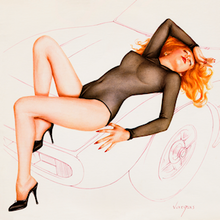Candy-O
| Candy-O | ||||
|---|---|---|---|---|
 |
||||
| Studio album by The Cars | ||||
| Released | June 13, 1979 | |||
| Recorded | 1979 | |||
| Studio | Cherokee Studios in Los Angeles | |||
| Genre | Rock, new wave | |||
| Length | 36:25 | |||
| Label | Elektra | |||
| Producer | Roy Thomas Baker | |||
| The Cars chronology | ||||
|
||||
| Singles from Candy-O | ||||
|
||||
| Professional ratings | |
|---|---|
| Review scores | |
| Source | Rating |
| Allmusic | |
| Robert Christgau | B+ |
| Smash Hits | 8/10 |
| Rolling Stone | (not rated) |
Candy-O is the second studio album by the American rock band The Cars. It was released in 1979 on Elektra Records. Featuring the Top 20 hit "Let's Go" and the minor hit "It's All I Can Do", the album charted 15 places higher than its predecessor on the Billboard Hot 100. The album features cover art by pin-up artist Alberto Vargas.
Unlike the first album, Candy-O was created under a more democratic approach. Ric Ocasek said of this, "When one of my songs goes to the band in barest cassette form, we sit around and talk about it. If I’m outvoted, we don’t do it. “We almost didn’t include 'Double Life' on the new album, it had been dropped. I think everybody in the Cars is open-minded and creative enough that they would do anything — nobody’s holding anything back. Everybody appreciates the more radical, experimental kinds of music and likes it. But sometimes, when you’re put together with five pieces, things are not as minimal as they could or should be. Everybody’s developed a unique personal style, and we rely on their input. If they did it, it’s good enough."
Most of the songs on Candy-O were written after the release of The Cars, meaning that most of the leftovers from the first album (including the popular encore "Take What You Want") were scrapped; "Night Spots", a reject from the first album, was still included.
For the album, the band once again worked with Queen producer Roy Thomas Baker. Ocasek said of their relationship with the producer, "Well, some of the things on that first album that we thought were a little slick, we toned down on the second, like on the background vocals. But if we were going to rely on the producer we had hired, there was no reason to try and change him. On the second album, it was easier to say, 'Roy, let’s not do the multi-tracked harmonies this time.'"
...
Wikipedia
